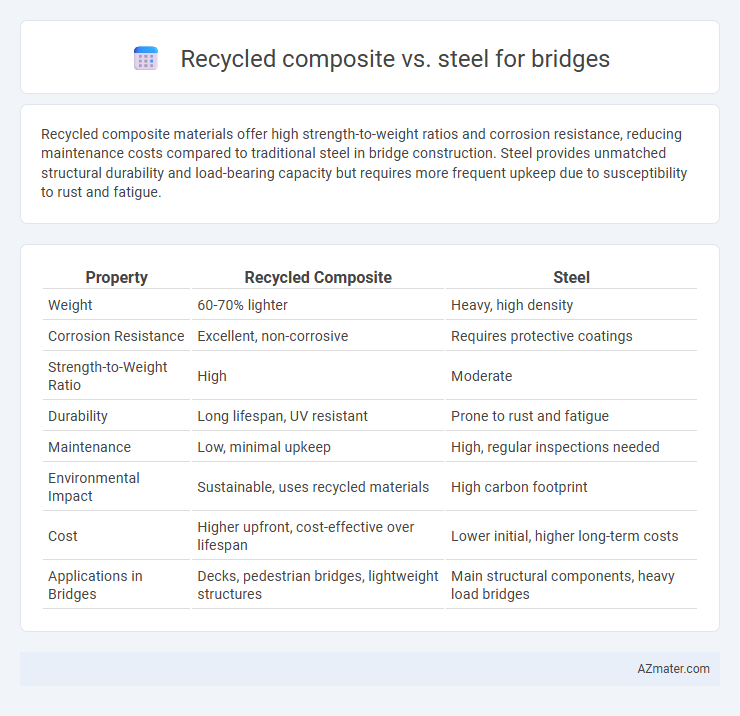Recycled composite materials offer high strength-to-weight ratios and corrosion resistance, reducing maintenance costs compared to traditional steel in bridge construction. Steel provides unmatched structural durability and load-bearing capacity but requires more frequent upkeep due to susceptibility to rust and fatigue.
Table of Comparison
| Property | Recycled Composite | Steel |
|---|---|---|
| Weight | 60-70% lighter | Heavy, high density |
| Corrosion Resistance | Excellent, non-corrosive | Requires protective coatings |
| Strength-to-Weight Ratio | High | Moderate |
| Durability | Long lifespan, UV resistant | Prone to rust and fatigue |
| Maintenance | Low, minimal upkeep | High, regular inspections needed |
| Environmental Impact | Sustainable, uses recycled materials | High carbon footprint |
| Cost | Higher upfront, cost-effective over lifespan | Lower initial, higher long-term costs |
| Applications in Bridges | Decks, pedestrian bridges, lightweight structures | Main structural components, heavy load bridges |
Introduction to Bridge Construction Materials
Recycled composite materials in bridge construction offer enhanced corrosion resistance and reduced environmental impact compared to traditional steel. Steel remains a preferred material due to its high tensile strength, durability, and established load-bearing performance in bridge engineering. Advances in recycled composites are driving innovation by providing lightweight alternatives with improved fatigue life and lower maintenance costs.
Overview of Recycled Composite Materials
Recycled composite materials for bridges consist of repurposed plastics, fibers, and resins, offering high durability and resistance to corrosion compared to traditional steel. These composites significantly reduce environmental impact by diverting waste from landfills while maintaining structural integrity under heavy loads. Their lightweight nature and low maintenance requirements contribute to longer service life and cost-efficiency in bridge construction and repair projects.
Steel: Traditional Choice for Bridges
Steel remains the traditional choice for bridge construction due to its exceptional strength, durability, and flexibility under heavy loads. Its high tensile strength and proven performance in diverse environmental conditions ensure long-lasting structural integrity. Maintenance is well-understood with established repair techniques, making steel a reliable material despite the rising interest in recycled composite alternatives.
Strength and Durability Comparison
Recycled composite materials used in bridge construction offer high strength-to-weight ratios, often surpassing traditional steel in resistance to corrosion and environmental degradation. Steel maintains superior tensile strength and load-bearing capacity but requires ongoing maintenance to prevent rust and fatigue over time. The durability of recycled composites reduces lifecycle costs and extends service life, making them a competitive alternative for sustainable bridge infrastructure.
Environmental Impact Assessment
Recycled composite materials used in bridge construction demonstrate a significantly lower carbon footprint compared to traditional steel, reducing greenhouse gas emissions by up to 60% during production. Life cycle assessment studies reveal that composites contribute less to resource depletion and generate minimal waste due to their recyclability and extended durability. Steel bridges, while strong and recyclable, require high energy input for smelting and fabrication, leading to greater environmental impact throughout their life cycle.
Cost Analysis: Initial and Lifecycle
Recycled composite materials typically offer lower initial costs compared to steel due to reduced material and fabrication expenses, along with simplified installation processes. Lifecycle cost analysis reveals that recycled composites require significantly less maintenance and resist corrosion, thereby decreasing repair and replacement expenditures over time. Steel, while durable, incurs higher long-term costs related to rust prevention, frequent inspections, and potential structural fatigue, resulting in increased total ownership expenses.
Maintenance and Longevity Factors
Recycled composite materials used in bridge construction exhibit superior resistance to corrosion and weathering compared to traditional steel, significantly reducing maintenance frequency and costs. Steel bridges require regular inspections, painting, and rust prevention treatments due to their susceptibility to oxidation and environmental degradation. The longevity of recycled composite bridges can exceed several decades with minimal upkeep, making them a cost-effective and durable alternative to steel in long-term infrastructure projects.
Design Flexibility and Structural Performance
Recycled composite materials offer superior design flexibility for bridges due to their lightweight properties and ability to be molded into complex shapes, allowing innovative architectural designs. Steel provides exceptional structural performance with high tensile strength and durability, making it ideal for heavy load-bearing applications and long-span bridges. The choice between recycled composites and steel depends on balancing the need for versatile aesthetics against stringent structural demands and maintenance considerations.
Case Studies: Recycled Composite vs Steel Bridges
Case studies comparing recycled composite and steel bridges reveal significant differences in durability and maintenance costs, with recycled composite bridges demonstrating superior resistance to corrosion and a longer lifecycle under harsh environmental conditions. For example, the Deh Cho Bridge in Canada utilized recycled composite materials, resulting in a 30% reduction in lifecycle costs compared to traditional steel structures. These findings highlight the potential of recycled composites to improve sustainability and reduce long-term expenses in bridge construction.
Future Trends and Innovations in Bridge Materials
Recycled composites are gaining traction in bridge construction due to their reduced environmental impact and superior corrosion resistance compared to traditional steel. Innovations in nanotechnology and bio-based composites are enhancing the strength-to-weight ratio and durability of recycled composites, promising longer lifespans and lower maintenance costs. Future trends indicate a shift toward hybrid materials combining recycled composites with steel to optimize structural performance and sustainability in bridge engineering.

Infographic: Recycled composite vs Steel for Bridge
 azmater.com
azmater.com